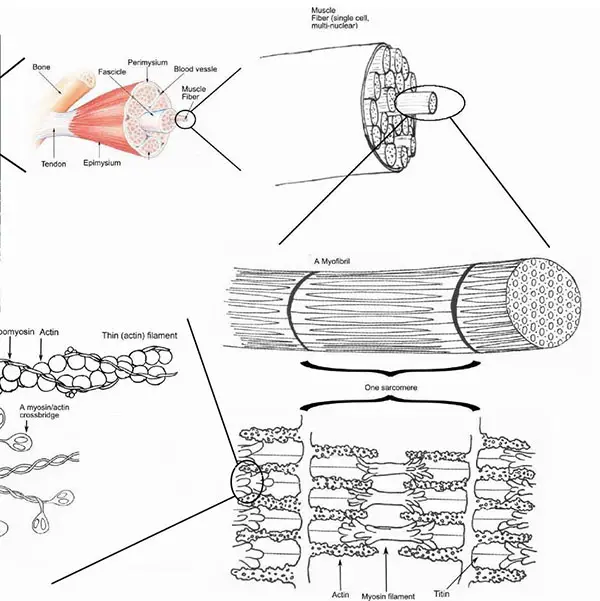Muscle Contractility
The most important property of a muscle is its contractility.
When appropriately stimulated, the muscle fibers contract and pull upon the inelastic tissues surrounding them. It is customary to divide muscular contraction into two types:
- a single, momentary contraction, known as a twitch, which is always involuntary, and
- a more or less sustained contraction, known as tetanus. [1]
Tetanic in Nature
Question: What does it mean when muscle contractions are tetanic in nature?
When muscle contractions are described as "tetanic in nature," it means that the contractions occur rapidly and continuously, without relaxation, resulting in a sustained and prolonged contraction of the muscle fibers. This state is known as tetanus or tetanic contraction. In a normal muscle contraction, the muscle fibers receive signals from motor neurons, causing them to contract and generate force. After each contraction, there is a brief period of relaxation before the next contraction can occur. However, in tetanic contractions, the muscle fibers are stimulated at such a high frequency that they do not have enough time to relax fully between contractions. Tetanic contractions can be caused by various factors, including electrical stimulation, certain medical conditions, or the administration of certain drugs or toxins. Tetanus, a bacterial infection caused by the bacterium Clostridium tetani, is a well-known example of a condition that leads to tetanic muscle contractions. When a muscle is in a tetanic state, it can result in sustained muscle stiffness, spasms, and rigidity. This continuous contraction can be detrimental to normal muscle function and can lead to muscle fatigue or even muscle damage if sustained for an extended period.
When muscle contractions are described as "tetanic in nature," it means that the contractions occur rapidly and continuously, without relaxation, resulting in a sustained and prolonged contraction of the muscle fibers. This state is known as tetanus or tetanic contraction. In a normal muscle contraction, the muscle fibers receive signals from motor neurons, causing them to contract and generate force. After each contraction, there is a brief period of relaxation before the next contraction can occur. However, in tetanic contractions, the muscle fibers are stimulated at such a high frequency that they do not have enough time to relax fully between contractions. Tetanic contractions can be caused by various factors, including electrical stimulation, certain medical conditions, or the administration of certain drugs or toxins. Tetanus, a bacterial infection caused by the bacterium Clostridium tetani, is a well-known example of a condition that leads to tetanic muscle contractions. When a muscle is in a tetanic state, it can result in sustained muscle stiffness, spasms, and rigidity. This continuous contraction can be detrimental to normal muscle function and can lead to muscle fatigue or even muscle damage if sustained for an extended period.
Neural Stimulation
In neural stimulation the impulses reach the muscle fibers at intervals shorter than the time needed for the muscle to return to its original state. As a result, summation of contraction takes place. The chief characteristic of this summation is that it exceeds the maximum contraction possible with a single stimulation. Its greater duration of contraction is obvious, since the movement is the response to a series of successive stimuli.
The contractility of a muscle varies further with the intensity of the stimulus. A very weak stimulus may be insufficient to produce any movement. As the intensity of the stimulus increases, a point will be reached at which slight contractions occur. A further increase in intensity will result in an increase in contraction. In voluntary movement it is difficult to reach a complete maximum because the nature of the stimulus is psychological, and depends upon such unstable factors as the will, besides being dependent upon circulation and respiration.

In physiology, muscle contraction does not mean muscle shortening because muscle tension can be produced without changes in muscle length such as holding a heavy weight at the same position. The termination of muscle contraction is followed by muscle relaxation, which is a return of the muscle fibers to their low tension-generating state.
[1]
tetanus: n. [L. < Gr. tetanos, spasm (of muscles), lit., stretched: for IE. base see TEND:] 2. Physiol. the state of continuous contraction of a muscle, especially when caused experimentally by a series of rapidly repeated stimuli.
Physiological Mechanics of Piano Technique